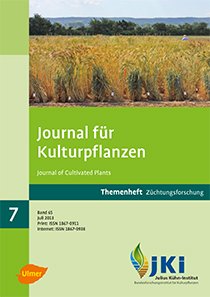Mutagenesis and polyploidization for creation of new genetic variability of Hydrangea macrophylla
Keywords:
FISH, flow cytometry, hortensia, mutagenesis, polyploidization, trifluralin, X-ray irradiationAbstract
The suitability of induced mutagenesis and polyploidization of Hydrangea macrophylla to be incorporated in breeding programs was investigated. For mutagenesis nodal explants in vitro of variety Blaumeise were irradiated with X-rays (5, 10, 20 and 30 Gy). The lethal dose of 50% was between 20 and 30 Gy. Irradiated plants were transferred to the greenhouse. New phenotypic traits like dwarfism, deformed leaves or black stems were observed. Polyploidization was carried out on nodal explants in vitro, too. Plant material was from the diploid varieties Adria and Libelle as well as from the triploid varieties Blaumeise and Nachtigall. For mitosis inhibition colchicine and trifluralin were used. After treatment with colchicine only four ploidy chimeric plants were found. The effectiveness of trifluralin was much better. Already after treatment with 0.001% trifluralin polyploidized plants were received. Hexaploid plants showed a strong dwarfism and deformed leaves. By contrast, tetraploid plants were attractive like the diploid origins. The flow cytometry enabled rapid ploidy estimation and after the fluorescence in situ hybridization with gene sequences of 5S and 18/25S rDNA the karyotypes were characterized. Each ribosomal DNA sequence used was localized one time on the haploid genome on different chromosomes. The relevance of mutagenesis and polyploidization for creation of pre-breeding material will be discussed. Especially the utilization of tetraploid hydrangeas seems to be a useful tool for the development of new hydrangea varieties.
DOI: 10.5073/JfK.2013.07.03, https://doi.org/10.5073/JfK.2013.07.03








